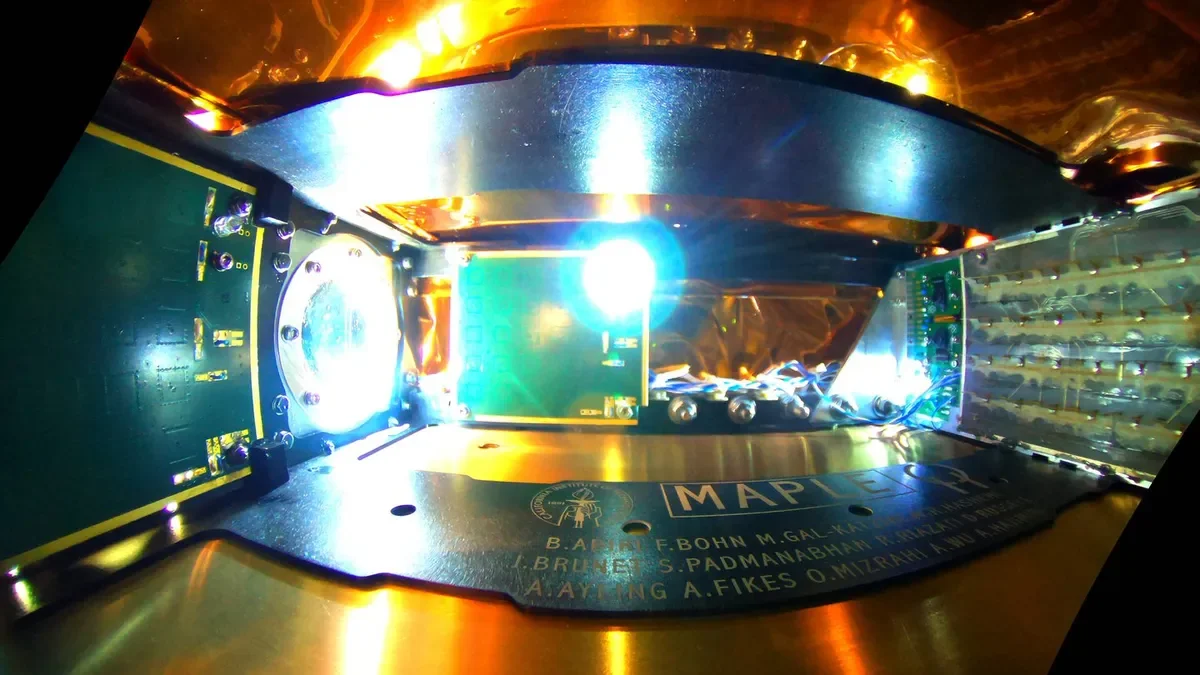From Demo to Utility: What Caltech’s SSPD-1 Actually Proved
The interior of MAPLE, an instrument aboard Caltech’s Space Solar Power Demonstrator, and one of three space-based solar power experiments to achieve the wireless transmission of energy through space.
Credit: Caltech
Caltech’s orbital testbed turned SBSP from artwork into engineering constraints—and that’s commercial gold
Space-based solar power (SBSP) has lived in glossy illustrations for decades. Caltech’s Space Solar Power Demonstrator (SSPD-1) finally put hard numbers around it. Launched in January 2023 and concluded in January 2024, SSPD-1 flew three experiments: MAPLE (microwave array for power beaming), DOLCE (a lightweight deployable structure), and ALBA (a portfolio of solar cells for on-orbit comparison). It wasn’t about megawatts; it was about closing sub-problems in space, with telemetry you can build a business on.
First, the headline: MAPLE wirelessly transmitted power in space and directed a detectable signal to a ground receiver—the first public demonstration of any SBSP element delivering energy from orbit to Earth, however small the wattage. That matters because it validates end-to-end RF control and phasing under real thermal and radiation conditions, not just in an anechoic chamber. Caltech documented the result in June 2023 and summarised lessons at the mission wrap in January 2024.
Second, DOLCE proved that a lightweight deployable platform—a precursor to much larger solar arrays—can be packaged, released and observed with in-situ cameras. Nothing in space deploys perfectly; that’s the point of flying it. DOLCE’s performance (and the anomalies) are exactly the sort of data suppliers of trusses, hinges and membranes need before scaling to hectare-class collectors. Caltech’s close-out notes stress that “success with surprises” is the right outcome for a pathfinder, because it moves deployment away from renderings and into measurable tolerances.
Third, ALBA compared dozens of solar cell technologies side-by-side in orbit—efficiency vs. degradation vs. mass—and returned durability and performance cuts you can feed into a serious mass/area model. For integrators, that helps decide whether to chase bleeding-edge efficiency or bank on rugged cells with better lifetime economics when you include launch, assembly and replacement.
What does this unlock commercially? Above all, credible architecture trade-offs. Buyers (utilities, defence, agencies) will not sign cheques for “SBSP in general”; they’ll back specific stacks: tile efficiency and lifetime; beam-forming accuracy; thermal limits; and rectenna interface assumptions on the ground. SSPD-1’s data lets vendors show their working—why their tile spacing, phasing network and thermal path beat alternatives—without hand-waving. That’s how you move from a science project to a product line.
It also joins up with the wider policy backdrop. NASA’s January 2024 assessment asked when SBSP might be economically competitive under plausible future costs: launch pricing, cell efficiency, learning curves, on-orbit servicing, and electric propulsion for station-keeping all feature in the calculus. ESA’s SOLARIS programme has been digesting those findings and Europe’s own system studies, framing milestones that could make an SBSP commitment investable by the end of 2025. SSPD-1’s results don’t decide those questions—but they de-risk the inputs.
So how do you package this for market now? Think modules and services, not monoliths. Offer reference tiles and beam-control stacks with flight-heritage parameters; license simulation models validated by SSPD-1 so grid and spectrum planners can test rectenna footprints and sidelobe limits; and sell availability demos—fixed-duration beaming sessions with audited efficiency and link stability—rather than one-off spacecraft sales. Caltech’s own storyline makes the positioning easier: “we flew the sub-systems; here’s what changed between lab and orbit; here’s how we’ve baked that into our kit.”
Risk needs plain speech. Spectrum coordination, environmental reviews for rectennas, thermal runaway in dense arrays, deployment reliability—none of these are solved by a single cubesat. But bounded milestones are attractive to investors and insurers: improve link efficiency by a stated increment; cut deployment time by a known factor; extend tile lifetime by a measurable margin. Publish before/after deltas and invite independent test witnesses to qualification—habits respected in adjacent programmes will calm energy-sector buyers.
Finally, cadence will trump payload mass. A regular drumbeat of small, instrumented flights that sharpen beam control, tile lifetime and deployment repeatability is more valuable than a single heroic attempt at scale. Use SSPD-1 as your pattern: fly, measure, adapt, publish. That rhythm, plus a services posture, is what turns SBSP from a headline into a backlog. Caltech showed how to take the first steps—from demo to utility via data. The commercial teams who follow that path will own the early market.
